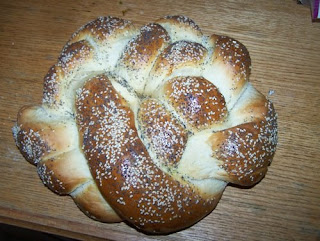The day started early; I rose at 5 a.m. to start the dough for hot cross buns (which we always have on Easter morn) and challah bread, which I frequently make for feast days. Then while the dough was rising, I chanted Mattins and then enjoyed my first cup of coffee since Mardi Gras, because I gave up coffee for Lent. Then on to baking the hot cross buns and challah bread, and making the deviled eggs which I wrote about last year.
We picked up my sister Cindy on the way to Mass and spent a little time after Mass visiting with friends there, before heading home to finish dinner preparations.

We had three guests for dinner, my sister Cindy, my friend Fred, and a former co-worker Margaret. After enjoying the Easter deviled eggs and antipasto, we sat down to a dinner of baked ham, lasagna, baked-stuffed potatoes, asparagus, carrots & peas, and a new recipe for this year, Maple Bourbon Sweet Potatoe Casserole.
Mashed Maple Bourbon Sweet PotatoesIngredients
- 6 pounds sweet potatoes
- 1 lemon, zested and juiced (or orange, pace many commenters)
- 3 tablespoons pure maple syrup
- 2 tablespoons light brown sugar
- 3 tablespoons bourbon (or Irish Whiskey?)
- 8 tablespoons butter, at room temperature
- 1 1/2 teaspoons salt
- 1 teaspoon white pepper
- Pecan Crumb Topping, optional
Directions
Preheat the oven to 375° F.
Place the sweet potatoes on a foil lined baking sheet and roast for 45 minutes to 1 hour, until very soft to the touch. Remove from the oven and let cool 20 minutes. When cool enough to handle, peel them by hand and put the flesh in the bowl of a mixer. Using a paddle attachment, mix in the lemon zest and juice, maple syrup and brown sugar.
Place the bourbon in a small saucepan and place over high heat. Let it come just to the boil and then tilt the pan slightly towards you to set it aflame*. Add to the potatoes along with the butter. Mix well. Add salt and pepper and transfer to a 13 by 9-inch oven-safe casserole dish. (Recipe can be made to this point up to 2 days before, refrigerated.) Sprinkle topping over potatoes and bake for 20 minutes until the top is golden brown.
Alternatively, you may simply sprinkle the top of the casserole with a little bit of brown sugar and 1/2 cup chopped pecans.
*This method does not "burn off" the alcohol.
Pecan Crumb Topping:
- 1/2 cup all-purpose flour
- 1/4 cup packed light brown sugar
- 1 teaspoon salt
- 1/2 teaspoon ground white pepper
- Pinch dried thyme
- 1/2 cup chopped pecans
- 5 tablespoons butter, chilled and cut into bits
Mix the flour, brown sugar, salt, pepper, thyme and pecans together in a small bowl. Add the butter and work with your fingers until a crumbly mass forms.


